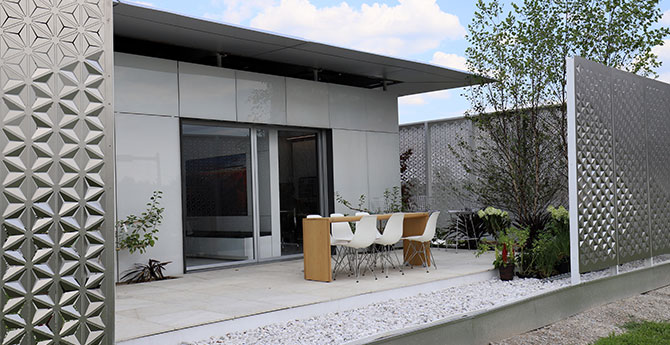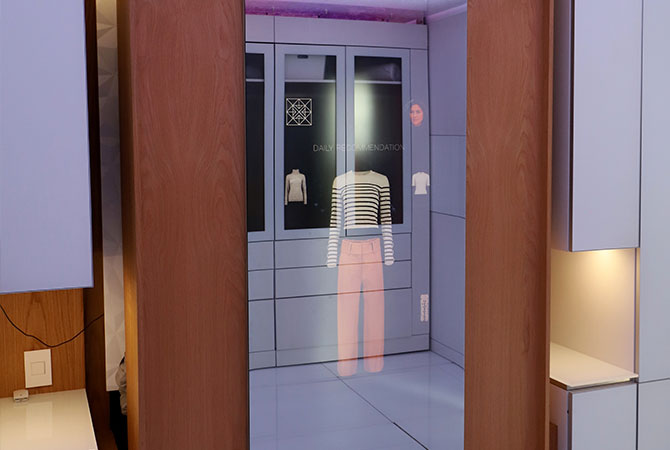In August, members of our Fairfax architectural group had the opportunity to visit FutureHAUS—a prototypical, prefabricated, energy-positive smart home in Alexandria, Virginia. FutureHAUS was designed by a team from Virginia Tech that placed first
in Dubai’s Solar Decathlon Middle East competition.

The solar decathlon challenged 15 universities from around the world to design, build, and operate energy-positive solar homes.
Virginia Tech’s FutureHAUS design features a prefabrication concept that can be assembled onsite and is easily transportable. It also features state-of-the-art technology that revolves around the idea of aging in place and accommodating users of
any age, height, or disability.
I found the concepts developed for the house to be innovative. There was a consistent thought process for designing the living environment for people with disabilities and the aging population to create an inclusive and space-efficient building.
First-Hand Experience
As a recent Virginia Tech graduate, I followed the timeline and success of FutureHAUS throughout my undergraduate education, and I couldn’t be prouder of the work and dedication put in by my colleagues and faculty for their achievement.
While touring the house, it was evident that the facility was designed with users in mind. FutureHAUS exemplifies this idea by designing for the culture in Dubai by inserting a foot wash station inside of the powder room for prayer preparation for
religious needs. With the floor sensor’s weight detection, each system in the house can accommodate and change with the resident using it, including changing counter heights and sink heights. The integration of technology promotes equality
and the ease of use inside the house.

FutureHAUS has many concepts that can be changed and customized depending on the user, including making the counters and toilet height adjustable. The rooms can also be changed depending on what it’s being used for.
My favorite aspect of the house was the fluidity of spaces. The living room could encompass an office, but if a family member needs to work, while another wants to watch a movie, a wall can be pulled out into the space to divide the area and create
more privacy. Even in the bedroom, the electronic Murphy bed can be stowed away during the day to make the room open and similar to a walk in closet.

Another interesting feature is that the closet can find a specific item using the smart mirror and tiny RFID tags the user tagged their clothes with to quickly scan and locate the item. The technological features in the house are well-thought-out and designed to make people’s lives easier.
Technology of the Future
There were many smart features installed in the FutureHAUS, including LED ceiling panels that change color when the front door is knocked on, a kitchen faucet that allows for the control of the temperature and dispensing of water, an interactive display
in the counter, and adjustable height fixtures. They also integrated a drone delivery hatch in the house.

The ceiling features LED panels that change colors if someone knocks on the front door. The features can be customized in the house depending on the users.
From solar panels to a water-recycling shower, the FutureHAUS is able to produce enough energy to be off the grid and net positive. Joe Wheeler, an architecture professor and leading member of the FutureHAUS team, believed the water-recycling shower with
a filtration system that determined the cleanliness of the water was one of the biggest reasons his team was able to win the solar decathlon in Dubai. I think these could be used in other building designs to help lessen our energy consumption and
overall impact on the environment.
The Future of Sustainability
I think we’ll see the implementation of more solar power and sustainable efforts in the future. Solar power is becoming a more common discussion topic, and hopefully more solar panels will be implemented into future and already built homes and buildings. Already with the Architecture
2030 Challenge, and the increasing knowledge and understanding of building footprints on the world, giant steps are being taken to reduce our waste. Using solar power would not only help residents save money, but it would give a greater value
to the house or building.
I enjoyed the experience of getting to tour the FutureHAUS to see the creative sustainable features that are being implemented in our future buildings and living spaces, and how technology is being incorporated into these everyday spaces.